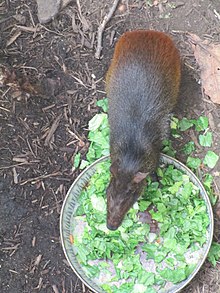| Red-rumped agouti | |
|---|---|

| |
| Conservation status | |
 Least Concern (IUCN 3.1) | |
| Scientific classification | |
| Domain: | Eukaryota |
| Kingdom: | Animalia |
| Phylum: | Chordata |
| Class: | Mammalia |
| Order: | Rodentia |
| Family: | Dasyproctidae |
| Genus: | Dasyprocta |
| Species: | D. leporina |
| Binomial name | |
| Dasyprocta leporina (Linnaeus, 1758) | |

| |
| Geographic range | |
| Synonyms | |
|
Mus aguti Linnaeus, 1766 | |
The red-rumped agouti (Dasyprocta leporina), also known as the golden-rumped agouti, orange-rumped agouti or Brazilian agouti, is a species of agouti from the family Dasyproctidae.
Distribution
It is native to northeastern South America, mainly in Venezuela, Guyana, Suriname, French Guiana, northeastern Brazil, Trinidad and Tobago and Saint Lucia in the Caribbean. It has also been introduced to Florida, the U.S. Virgin Islands, Grenada, and Dominica.
Names
Despite the alternative name Brazilian agouti, it is neither the only nor the most widespread species of agouti in Brazil. In Brazil all agoutis are often called "cutia" [kuˈtʃiɐ].
Habitat
It is found in a wide range of forests, including rainforest and secondary forest.

Description
Red-rumped agoutis weigh about 3 to 6 kilograms (6.6 to 13.2 lb). They are about 48 to 64 cm (19 to 25 in) long. The females are larger than males but otherwise look similar. They are brownish with darker spots on the upper body. The fur becomes more orange as it goes past (going down) the middle area of the animal. The ears are somewhat square in shape. The front feet have four toes and the back have three each. They can be distinguished from other agoutis by their distinct coloring.
They have no distinct breeding season, but females come into season twice a year and generally have one to four young. The gestation period is 104 to 120 days. On average, it takes 20 weeks for the young to be weaned. They live in pairs or family groups of the parents and babies. They need large areas for food, breeding, and territory; because of this, keeping them in captivity is difficult. It lives 15-20 yrs in captivity.
Diet
Food mostly consists of seeds, pulp, leaves, roots and fruits. They also feed on insect larvae when plant resources are low. They are known to feed on and disperse Astrocaryum aculeatissimum seeds, as well as Hymenaea courbaril seeds.
References
- ^ Emmons, L.; Reid, F. (2016). "Dasyprocta leporina". IUCN Red List of Threatened Species. 2016: e.T89497102A22197762. doi:10.2305/IUCN.UK.2016-2.RLTS.T89497102A22197762.en. Retrieved 12 November 2021.
- ^ Woods, C.A.; Kilpatrick, C.W. (2005). "Infraorder Hystricognathi". In Wilson, D.E.; Reeder, D.M (eds.). Mammal Species of the World: A Taxonomic and Geographic Reference (3rd ed.). Johns Hopkins University Press. pp. 1538–1600. ISBN 978-0-8018-8221-0. OCLC 62265494.
- "The Online Guide to the Animals of Trinidad and Tobago" (PDF).
- ^ "Dasyprocta leporina (Red-rumped Agouti)" (PDF). Sta.uwi.edu. Retrieved 9 April 2022.
- Pires, Alexandra; Galetti, Mauro (December 2012). "The agouti Dasyprocta leporina (Rodentia: Dasyproctidae) as seed disperser of the palm Astrocaryum aculeatissimum". Mastozoologia Neotropical. 19 (1).
- John F. Eisenberg and Kent H. Redford, 2000. Mammals of Neotropics: Ecuador, Bolivia and Brazil.
- Bricklin, R. and P. Myers. 2004. "Dasyprocta leporina" (On-line), Animal Diversity Web. Accessed December 12, 2006 at ADW: Dasyprocta leporina: CLASSIFICATION
External links
 Media related to Brazilian Agouti at Wikimedia Commons
Media related to Brazilian Agouti at Wikimedia Commons Data related to Brazilian Agouti at Wikispecies
Data related to Brazilian Agouti at Wikispecies
| Taxon identifiers | |
|---|---|
| Dasyprocta leporina | |
- IUCN Red List least concern species
- Dasyprocta
- Mammals of the Caribbean
- Rodents of Brazil
- Mammals of French Guiana
- Mammals of Guyana
- Mammals of Suriname
- Mammals of Trinidad and Tobago
- Mammals of Grenada
- Mammals of Dominica
- Mammals of Venezuela
- Fauna of the Amazon
- Fauna of the Guianas
- Fauna of the Lesser Antilles
- Mammals described in 1758
- Taxa named by Carl Linnaeus